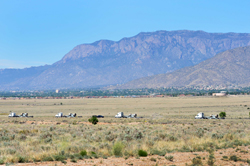ALBUQUERQUE, N.M. — The last scheduled shipments of remote-handled (RH) transuranic (TRU) waste left Sandia on Wednesday, headed directly for permanent disposal in the Department of Energy’s (DOE) Waste Isolation Pilot Plant (WIPP) near Carlsbad, N.M. These shipments end Sandia’s final stage in DOE’s Legacy TRU Waste Program, which works to safely remove such waste from sites throughout the DOE complex.
“Today’s last scheduled shipment of remote-handled transuranic waste from Sandia demonstrates our commitment to the cleanup of legacy waste at DOE sites here in New Mexico and across the nation,” DOE Environmental Management Principal Deputy Assistant Secretary Tracy Mustin said. “Disposition of these materials helps us reduce our nuclear legacy footprint and minimize potential environmental risks well into the future.”
The waste is the byproduct of nuclear defense program research and weapons production. Much of the waste removed from Sandia came from programs completed in the 1980s. With American Recovery and Reinvestment Act funding, DOE has been given the task of reducing the nuclear footprint. Depending on the level of radioactivity, the waste was packaged for disposition in lower-level contact-handled waste containers (CH-TRU) or higher-level remote-handled waste containers (RH-TRU).
Both the RH-TRU and CH-TRU disposed of at WIPP consist of tools, rags, protective clothing and other materials contaminated with radioactive elements that have atomic numbers greater than uranium (transuranic).
Beginning in the summer of 2011, employees in Non-Reactor Nuclear Facilities and WIPP Central Characterization Project (CCP) personnel from the Carlsbad Field Office, which leads the TRU waste management program for the DOE, worked in the Tech Area 5 Auxiliary Hot Cell Facility (AHCF) to analyze and repackage the RH-TRU waste for shipment. CCP personnel were able to certify the RH-TRU waste was compliant, so it could be sent directly to the WIPP facility for disposal.
The AHCF, a small, heavily shielded concrete box, was established specifically to process and disposition legacy nuclear material and waste. A crane brings waste materials into the cell through a roof door. Crew members examine the waste material through thick, leaded windows, and use glove box-style manipulator arms to examine the material and take samples.
Workers also confirm that the waste materials have been correctly described and documented, and then repackage the waste, which is then removed through the cell’s roof door.
On Dec. 16, WIPP received the first of eight planned RH-TRU waste shipments from Sandia. WIPP is designed to safely isolate defense-related TRU waste from people and the environment. Operating since 1999, WIPP receives waste temporarily stored at sites around the country, and permanently disposes of it in rooms mined out of an ancient salt formation 2,150 feet below the surface.
Contact-handled removal
Prior to the removal of the RH-TRU waste, Radioactive Waste/Nuclear Material Disposition employees removed all of Sandia’s lower-level CH-TRU waste.
Beginning in December 2010, Sandia packaged and sent its CH-TRU waste to Idaho’s Advanced Mixed Waste Treatment Project, where it was certified that it met the criteria for CH-TRU waste disposal.
The first of three CH-TRU waste shipments left Sandia in December 2010, the second left in March 2011, and the final CH-TRU waste shipment left in October 2011. The CH-TRU waste sent in the first two shipments was certified in Idaho and shipped to WIPP for disposal. Drums from the final shipment were recently certified in Idaho and sent to WIPP.
The primary difference between RH-TRU and CH-TRU waste is the surface radiation dose to which a worker may be exposed when handling the packaged waste. If the surface radiation dose rate of a waste package is above 200 millirem per hour, it must be handled remotely, using equipment and shielding to protect workers from excessive radiation exposure.
Removing legacy TRU waste a priority
DOE Carlsbad Field Office Manager Joe Franco said the disposal of legacy TRU waste is important to WIPP and the nation. “We’re committed to future generations as we continue our cleanup mission safely, compliantly and efficiently.” He thanked Sandia for its contributions to the initiative.
Nationally, DOE has prioritized removing legacy TRU waste from small-quantity sites, such as Sandia. A small quantity site is a site that does not have enough waste to make it cost effective to become a certified site.
Removal of the TRU waste was also a contract incentive for Sandia, so completing the removal met a contractual requirement that was given high priority by the National Nuclear Security Administration (NNSA).
For Sandia, proper disposition of legacy waste reduces risk associated with continued storage. Another benefit is that it demonstrates the opening of a pathway for TRU waste so future projects that may generate similar materials have a way out the door.
Additionally, DOE also assured New Mexico legislators that removing legacy waste in New Mexico would be a priority. In addition to legacy TRU waste removal at Sandia, DOE has removed TRU waste from Los Alamos National Laboratory in northern New Mexico, with more than 950 shipments to WIPP for disposal.
The majority of the Sandia’s work was completed using Sandia funding. The DOE Carlsbad Field Office (CBFO) National TRU Program provided the contract support for characterizing the waste by WIPP CCP for disposal at WIPP and the contract carriers for transporting the waste to the facility. Since Sandia is a small-quantity site for TRU waste, CBFO funded the support the disposition of Sandia legacy TRU waste with American Recovery and Reinvestment Act dollars.
The last four RH-TRU shipments that left Wednesday concludes the scheduled cleanup of legacy TRU waste at Sandia.



